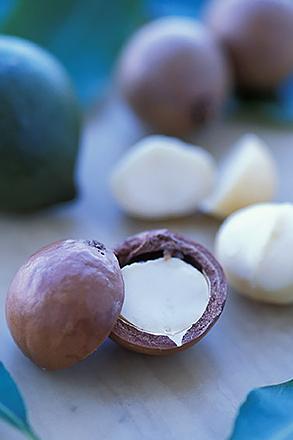The Curious Case of Macadamia Quick Decline
Sleuths Use Science to Uncover the Culprit Decimating Hawaii’s Nut Trees
Macadamia nut lovers came very close to losing their beloved snack about 30 years ago, but science saved the day. Now, the threat is back — and twice as dangerous.
Macadamia quick decline (MQD) has been a persistent problem in Hawaii since 1986 when it started killing productive 14- to 36-year-old macadamia trees in Hilo, Hawaii. Then, in the 1990s, one of the main nut growers lost more than 25,000 trees in a short period of time. The disease, Phytophthora tropicalis, had killed thousands of trees until scientists from the Agricultural Research Service (ARS) developed key diagnostic tests and an innovative fungicide delivery method that led to disease control.
However, after many years of successful management, P. tropicalis has re-emerged and is once again threatening the commercial and residential production of macadamia in the state. Not only that, but italso brought along a malicious friend, P. heveae.
"There could be a number of reasons as to why the new outbreak occurred," said Lisa Keith, plant pathologist at the ARS Tropical Plant Genetic Resources and Disease Research Unit in Hilo, HI. "The change in the environmental conditions, including temperature and rainfall, may contribute to better conditions that favor growth of the pathogen and its ability to cause disease. It is even possible that the new species causing MQD is more aggressive than the original pathogen and current management techniques don't work as well."
P. tropicalis typically enters the tree through the roots or through a wound above ground and grows in the tree's vascular system. From there, it blocks the water transport system and causes the tree to die. Until leaves start to change color, it is almost impossible to know that the tree has been infected.
Symptoms of P. heveae, the recently identified second pathogen, include dull green leaves scattered throughout the canopy, which can be difficult to see. As symptoms progress, "bleeding" occurs on the trunk and autumnal-looking leaf litter collects under the tree. Soon after, the tree dies.
"Phytophthora spreads through water the movement of soil, mud, or infected wood, so it is important to use effective management and sanitation protocols" Keith said. "P. heveae has a wide host range, so its presence in Hawaii poses a risk for avocado, mango, and cacao production."
Sanitation helps keep fields clean and new diagnostic tests can improve detection methods and fungal isolation protocols, Keith said. Further, ARS is testing macadamia varieties at the Hilo germplasm repository to find sources of host resistance so they can share information with growers.
"ARS researchers are working with macadamia growers and other researchers in Hawaii and around the world to assess the impact of Phytophthora diseases, develop improved management practices to minimize tree loss in mature orchards, and maintain the economic viability of the industry," she said.
Macadamia nut production in Hawaii is a $49 million industry, with about 1.2 million trees grown on 17,000 acres. Macadamia farms are located on the islands of Oahu, the big island of Hawaii, Maui, and Molokai.
Phytophthora had been controlled once, but came back, so ARS is prepared for any future episodes. Additional research for the Hilo team includes evaluating Phytophthora fungicide and application measures and gaining a better understanding of P. heveae — how it got to Hawaii, how and where it survives in nature, and how the inoculum source can be eliminated to prevent new outbreaks.
"My lab group and the macadamia industry worked together as an amazing team to unravel the mystery of the dying mac nut trees," Keith said. "We were able to expose the real fungal killer, which is the critical first step to figuring out how to manage it. Just like an episode of Scooby-Doo and Mystery Incorporated, perhaps P. heveae would have gotten away with it, if it weren't for us meddling kids." — By Scott Elliott, ARS Office of Communications.


